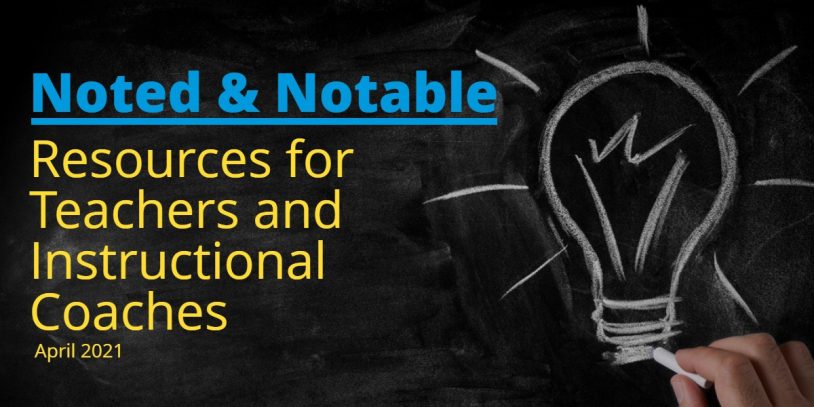Resources for Teachers and Instructional Coaches – April 2021

Spring has sprung, and this April we’ve been reading about social and emotional learning, getting a seat at the STEM community table, and post-pandemic staples. Check out some of our favorite recent reads and resources. Highlights and article links below!
Communication and collaboration abound in SEL
SEL, or social and emotional learning, is crucial to connecting with and engaging students. Here are some specific strategies for various SEL core competencies.
Done right, embedding SEL into our instruction builds a more supportive and equitable classroom environment. Both teacher-to-student and student-to-student interactions improve as the focus is on developing relationships through awareness, communication, and reflection.
Self-awareness: Starting a lesson with a check-in is a great way to help students practice self-awareness (an understanding of one’s inner life and how that affects behavior and decision-making); doing so also gives teachers a sense of students’ emotional entry point to learning.
Self-management: Guiding students toward setting goals and defining actionable steps to achieve those goals is one way to cultivate a student’s sense of self-management—the ways in which they manage their own learning.
Relationship skills: When students are purposefully grouped for instructional strategies such as during write-pair-share or Jigsaw, they work on their relationship skills. Teachers can support students as they develop these skills with group work that includes ice breakers and community building activities, as well as student conversation prompts (e.g., “What makes a good team?”).
Social awareness: Students can practice social awareness, which relates to students’ ability to empathize, when teachers highlight various ways to approach a problem and show the value of multiple perspectives.
Read more on Edutopia: How to Embed SEL Into Your Instruction
Finding online teacher communities
As teachers are learning and innovating like never before, tapping into online teacher communities is invaluable. Here are places to look for online STEM circles—tips can be applied generally to help any content teacher find platforms to connect with other educators.
- Ask your “in-person” peers. The best way to find an online community is often as simple as asking your school’s technology coordinator or STEM lead where to look. Other teachers or administrators may also be able to point you to their favorite online communities.
- Join an established online network. Here are some of my favorite online teacher communities:
- ISTE: If you’re looking for a Professional Learning Networks (PLNs) that bring together educators from around the world to provide a global perspective, then this is a great community to join.
- GEG Facebook Community: The Google Suite teacher community shares effective practices and teaching strategies. They also offer tech troubleshooting helpful tips and tricks which is extremely helpful in today’s virtual classroom.
- SEL Facebook Group: This is a space for everyone interested in social emotional learning (SEL) and emotional intelligence. The group is full of supporters for integrating SEL into education, advocates for research on SEL best practices, and champions of SEL as something that can benefit all teachers.
- Search hashtags. Use hashtags to find communities and continue to join conversations related to everything from STEAM and robotics to SEL distance learning tactics.
Read more on SmartBrief: Building a teacher community for STEM educators
We’re waiting for the pandemic to be over… but which innovations should continue?
After adjusting and innovating in many ways for teaching during the pandemic, professors, teachers, and students have found that some of the new practices are worth keeping. Read on for some of the ideas we’d vote to save.
Flexibility with due dates and grading. Flexibility and leniency have historically been problematic words in higher education, raising the suspicion that faculty members are “going easy” on students. Yes, many professors did scale back their requirements during the pandemic. But several readers told us that they realized that being flexible, such as with deadlines, is not the same as giving students a pass. Rather, it’s a sign of trust that students want to do their best but can’t always meet a particular schedule.
Taking time to make connections. Several readers told us that they had built time into their classes to simply talk to students, and that the approach had paid off in ways both expected and surprising. Some used prompts to start conversations, or began open-ended discussion to allow students to share what was on their minds. They knew these chats would help build connections within their virtual classrooms. One unanticipated benefit was that it helped them better understand the competing pressures in their students’ lives. Combined, these strategies led professors to see the link between engagement and learning.
Online tutoring and other student-support services. Several readers noted that when you make it easier for people to connect, it turns out more are willing to do so.
Read more on The Chronicle of Higher Education: Teaching: After the Pandemic, What Innovations Are Worth Keeping?
Missed our March notable content? Find it here!
